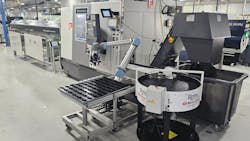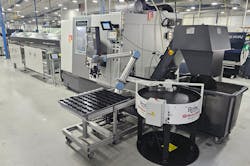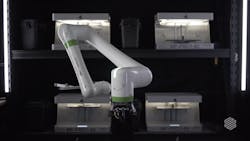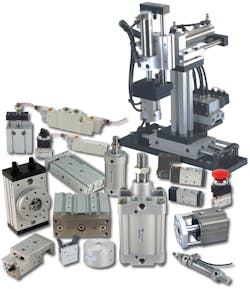Barely There: Replacing Manual Operations with Lights-out Processes
At a Glance:
- Whether the benefits of lights-out automation outweigh the costs depends on the situation. An undeniable benefit, however, is flexibility.
- Athena 3D commissioned Delta Technology, a systems integrator, to develop a turnkey robotic automation system that could keep production going 24/7.
- At Fabco-Air, primary operators at the machining centers have an app on their phones. They can watch their dashboard offsite and know enough about what’s going on inside the plant to make a decision.
Ambitions for achieving lights-out production have been around for decades. Yet, the number of manufacturers that boast of end-to-end automation—where the facility can operate in the dark for a period of time with minimal or no human supervision—remain the exception to the rule.
Among the early adopters, FANUC, which produces robotics, CNC and motion control, is a stalwart. Back in 2001 the Japanese company made it known that it used lights-out manufacturing techniques. “These were robots making robots, robots making the motors…we’re making the CNC controllers, assembling the computer boards,” said Jerry Perez, executive director of Global Accounts and manager of Business Development at FANUC Americas.
By one estimate, the factory employs lights-out automation technologies by using robots to build robots at a rate of 50 in a 24-hour shift and can run untended for up to 30 days.
The foundation for the journey started in the 1980s, estimated Perez. “There’s a lot of work that went into making that happen. So, when I hear lights-out-type technologies, I hear journey,” he said.
Hot Demand for Automation
The work that goes into lights-out automation is underpinned by what is communicated—between machine and machine and from process to process—and is today well within reach of manufacturers.
“Think of a factory: There are things that people are doing. They’re communicating, monitoring different [equipment], and then inspecting and testing those things,” said Perez. “For each of those aspects the technologies and devices [and functionality they deploy] didn’t necessarily exist 15 years ago, particularly the ones that one could add on and retrofit.”
In the past five years, Perez argued, it hasn’t become easier, but it is “more doable and more feasible for companies to begin that journey by taking their existing equipment and adding some central devices to get equipment communicating.”
Turning the 3D Printing Business Equation on its Head
In one FANUC case study, engineers solved production volume and efficiency concerns for Athena 3D, an additive manufacturing and engineering services provider based in Tempe, Ariz.
With production volume in mind and to meet demand, the additive manufacturer typically would run multiple 3D printers simultaneously. Once a print run is complete, machines would sit idle because the next job was dependent on having an operator change out the print bed. In some instances, the company would have up to 16 printers to change out manually. Since operators would return to the facility the next day, the lag translated into a significant amount of time and efficiency lost between print runs.
To optimize the use of machines, Athena 3D commissioned Delta Technology, a systems integrator, to develop a turnkey robotic automation system that could keep production going 24/7. The solution allowed the 3D printers to be programmed according to specifications before automatically queuing up the next job. In other words, when one print job is completed in the middle of the night, a FANUC CRX-10iA cobot can remove the print bed, set it on a storage rack and install a clean print bed into the printer. The Application Programming Interface (API) then instructs the printer to start the new job.
Athena 3D’s technicians boast of pumping out twice the number of parts and a 40% increase in the use of the technology, noted the case study. Technicians are reassigned to complementary, high-level tasks, such as quality control, maintenance and process management.
Created in 2019, Athena 3D is a relatively new company. The use of a lights-out solution to produce on demand, along with the ability to ramp up production under tighter deadlines, has given the company an edge in record time.
Unattended Nights and Weekends
Across the manufacturing spectrum, a slow and steady march to full automation has been implemented in varying iterations. Call it what you will—dark factories, lights-sparse factories or crewless cells—the goals for agile automation remain constant: take advantage of new operational efficiencies, reduce errors, accelerate product lifecycles, decrease labor and materials costs, and improve quality.
To achieve these goals, manufacturers turn to advancements in robotics, automation and 5G; innovative processes and operational technology; AI and ML; and VR and AR designed for industrial applications. That’s not to say that the highest level of automation is always the best choice; balancing the cost of optimizing existing production systems against the use of advanced technologies can help define an optimal automation strategy in assembly or production lines.
Neither is it a hard-and-fast rule. Analysts tend to suggest that lights-out automation methods are best suited to simple mass production of a standard product on a set schedule, but Fabco-Air is an exception to the rule.
READ MORE: Dark Factories: Science Fiction or Reality?
Located in Gainesville, Fla., Fabco-Air Inc. (a Festo company) produces pneumatic actuators and pneumatic control valves, and has used lights-out processing for the past 18 years. What makes the manufacturer unique in its lights-out offering is that it is a custom product, custom solution business. “So much of the product is low volume, high mix,” director of Operations Kevin Cradduck told Machine Design during a webinar exploring automation through lights-out manufacturing techniques. “We have a very complex business with a lot of product mix, and that creates very unique challenges, which Fabco-Air has developed a skill set for over the years.”
Fabco-Air’s use of lights-out technology is on the machining side—in the turning centers, said Cradduck, who joined the company in 2018 and has his finger on the pulse of advancements in technology and synchronous manufacturing processes. “We do a lot of machining, and especially a lot of turning. Many of our CNC machine centers are set up during our day shift and proven out. Then, the machines are set up to run all night and produce the components. Actually, they run all night and all weekend.”
For the most part, Fabco-Air employs conventional CNC turning centers. The CNC machines are fed by magazine bar feeders, which can load enough material to run fully unattended. Automatic parts collectors then collect the finished parts.
“We’ve done that well over the years,” said Cradduck. “Now, we’re really in what I would say is a refinement phase. We’re using newer technologies, by moving from traditional rotary parts collectors to now using robots to collect those parts at the end of the machines.”
A few advantages have sprung from upgrading the technology. “One is better part protection,” said Cradduck. “We don’t run the risk of damaging those parts. And another advantage is that we don’t have to do secondary operations to clean up while no one’s here. So, the robot will collect that part safely and put it in a containment device.”
The system also moves the component into parts inspection. “The robot feeds vision systems, and we inspect dimensional parts,” said Cradduck. “It does a couple of things: If we have a broken tool, we can feed that information back to the machine and tell it to shut off when it makes bad parts. Or we can decide to continue running that machine. But now we’ve segregated those parts.”
Another advantage is that Fabco-Air can feed that data to a FANUC controller integrated with the machines to automatically do tool offsets and adjust for tool wear while no one’s around.
If the potential for reaping benefits has been boosted by IT/OT technology, Cradduck reckons Fabco-Air is still on the learning curve when it comes to applying it. “Go back 15 years or so to when we started; the level of technology that we had were auto dialers on each of our machines,” he said. “If there was an error code and the machine would shut down during the night, the poor receiving person would receive an error code, wake up in the middle of the night and come in and turn these machines on. You talk about miserable, right?”
Those times have passed. Cradduck’s team, which has an average employee tenure of 25 years, is now collecting data in real time. “It’s doing a lot of things for us,” he said.
Primary operators at the machining centers have an app on their phones. When they’re offsite, they can watch their dashboard and know enough about what’s going on to make a decision. They may then consider whether it is it worth going back into work and correcting the problem.
“There are a number of factors that go into that,” said Cradduck. “It may be that the part they’re running is getting near the end of the spool, or the machine could only run two more hours. I’m not going to go into work for that. Or, it may be serious.”
If employee engagement is one consideration, building out capabilities is another. “The technology is also tying in very nicely with our total predictive maintenance program,” said Cradduck. “We’re now linking this technology with our software package. Where we see that going is that if there is a lights-out error, it feeds into that software package and sends a notification to our maintenance crew. They can make those same kinds of decisions.”
Advancing beyond that, Cradduck envisions the suite of technology will generate enough information to provide a diagnostic map to the maintenance crew. “Let’s say they do have to come in after hours, they will already have a diagnostic plan when they come in. They’ve got that technology in front of them.”
Iterative Processes Have Payoffs
Most companies tend to think of lights out as going from where they are today to no lights and no people. The reality is closer to Cradduck’s experience—a journey, said Perez, who joined Cradduck as a panelist on the lights-out webinar. “For the most part, you’re going to automate what you can and adjust what can be justified now. And it’ll be an iterative process.”
A logical next step would be to consider technologies that were not available off the shelf years ago but can now be installed to provide feedback from machines, and can re-adjust or calibrate automatically based on the current operation. For instance, sensor technologies can be used to inspect whether enough material was taken off during machining of a part, Perez said.
READ MORE: Lights-out Manufacturing: Myths Versus Realities
Festo, Fabco-Air's parent company, is aggressively moving to lean, synchronous manufacturing in all of its facilities, according to Cradduck. “And as we do that, we’ll probably start to implement more and more cobots, especially in assembly operations where we’re doing ‘hand-offs.’ It continues to drive efficiency.”
A general trend Perez has noticed with lights-out technology is that companies are developing off-the-shelf, standard solutions over time. The next iteration of Fabco-Air’s journey, he estimated, may require some customization. “To be able to say, ‘This went wrong. I need to show this maintenance diagram. But I need to take [a different] maintenance diagram and turn it into software code to automatically tell the machine to do something,’ hasn’t been done yet,” Perez pointed out.
But among the new technologies available today, it is reasonable to expect the industry to launch such solutions in the coming years, said Perez. “Could we implement that? Yes. Would it take money and time and coders today? Yes. But it could be part of the journey, and maybe Fabco-Air will be the trailblazer.”
Cradduck’s enthusiasm for his company’s next lights-out play is palpable. “We’re looking forward to seeing you visit us and Gainseville, Fla.,” he tells Perez.
About the Author

Rehana Begg
Editor-in-Chief, Machine Design
As Machine Design’s content lead, Rehana Begg is tasked with elevating the voice of the design and multi-disciplinary engineer in the face of digital transformation and engineering innovation. Begg has more than 24 years of editorial experience and has spent the past decade in the trenches of industrial manufacturing, focusing on new technologies, manufacturing innovation and business. Her B2B career has taken her from corporate boardrooms to plant floors and underground mining stopes, covering everything from automation & IIoT, robotics, mechanical design and additive manufacturing to plant operations, maintenance, reliability and continuous improvement. Begg holds an MBA, a Master of Journalism degree, and a BA (Hons.) in Political Science. She is committed to lifelong learning and feeds her passion for innovation in publishing, transparent science and clear communication by attending relevant conferences and seminars/workshops.
Follow Rehana Begg via the following social media handles:
X: @rehanabegg
LinkedIn: @rehanabegg and @MachineDesign




